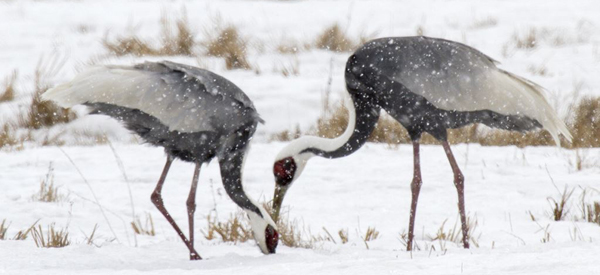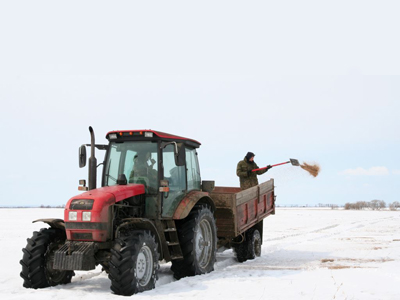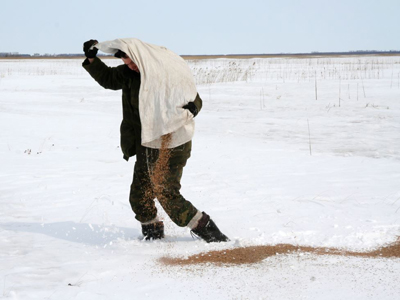
White-naped Cranes search for food at Muraviovka Park following spring blizzards in Far Eastern Russia.
By Sergei and Elena Smirenski
Muraviovka Park for Sustainable Land Use was established 20 years ago with ICF’s help in the Amur Region of Russia, to protect important breeding grounds of the endangered Red-crowned and White-naped Cranes. The Park has captive breeding/demonstration facilities for endangered cranes, geese and ducks, a Demonstration Farm, and conducts extensive wildlife research and public education programs. In August 2013, a major flooding of the Amur River created a state of emergency in this area, so the Park will need serious additional help from local, national, and international communities. For more information about the Park, visit www.muraviovkapark.ru and www.rbcu.ru. Learn more about our work in the Amur-Heilong River basin in East Asia.
 |
 |
In the southern Amur Region of Russia snowfalls are rare and disappear under the powerful forces of sunshine, cold, and wind long before the arrival of spring. So no one at Muraviovka Park expected the frequent and abundant snowfalls that lasted throughout this past winter and two months of spring. No wonder the arrival of migratory birds was significantly delayed. Cranes and storks arrived 12 days behind schedule. Not waiting any longer for milder weather, the birds began their journey home – as if they didn’t wish to return to their nesting site and find it taken over by squatters! A couple of warmer April days gave flickers of hope, but starting April 13th blizzards buried the wetlands, meadows, and crop fields under a thick white blanket, depriving wildlife of food for over ten days (above). In general, we do not believe artificial feeding is advisable under normal circumstances, but in such climate disasters it may be essential for crane survival. Besides, food for returning birds is always scarce in the Muraviovka area in early spring, and in good years Park staff plant corn to lure birds and spread up to 20 tons of wheat and barley in the fields, stored for this purpose in the Park’s barns. Lower yields in 2012 left little grain to spread at feeding sites, not enough to feed the hungry birds.
Through the Russian Bird Conservation Union website, TV stations, and newspapers we made a passionate appeals to the friends of birds in the Amur Region and beyond. The same day much needed help began to arrive! People started buying and delivering corn, wheat, and small fish that our staff and volunteers immediately brought to the fields (top right). The roads were a muddy mess and tractors could not go far, so our wonderful volunteers carried heavy bags of food on their backs for several hundred yards (bottom right). We were very happy to see that the cranes and storks spotted the food right away, were not shy of people, and by no means waited for a special invitation to the feast! The help kept coming. A neighboring co-op provided a truck and driver to help with shipping. Concerned people from Amur, other parts of Russia, Armenia, and USA began wiring money to the Park’s bank so we could buy and spread more fish and grain. The birds were saved.
The snow finally melted but Nature kept sending us new surprises. Typically, spring is dry, but this year frequent and abundant rains began pouring in April over melting snow and lasted through early June. Huge areas of cropland flooded and turned into wetlands; as a result, shore birds, ducks and grebes began building their nests in the crop fields. The water kept coming and flooded numerous nests of waterbirds. Once again our volunteers came to the rescue. We managed to save a White-naped Crane nest by bringing bundles of old grass and elevating the nest above the water level, and a few days later two chicks hatched.
Such prompt and overwhelming responses to our calls for help provide strong hope for the future for both birds and people of the Amur Land!
